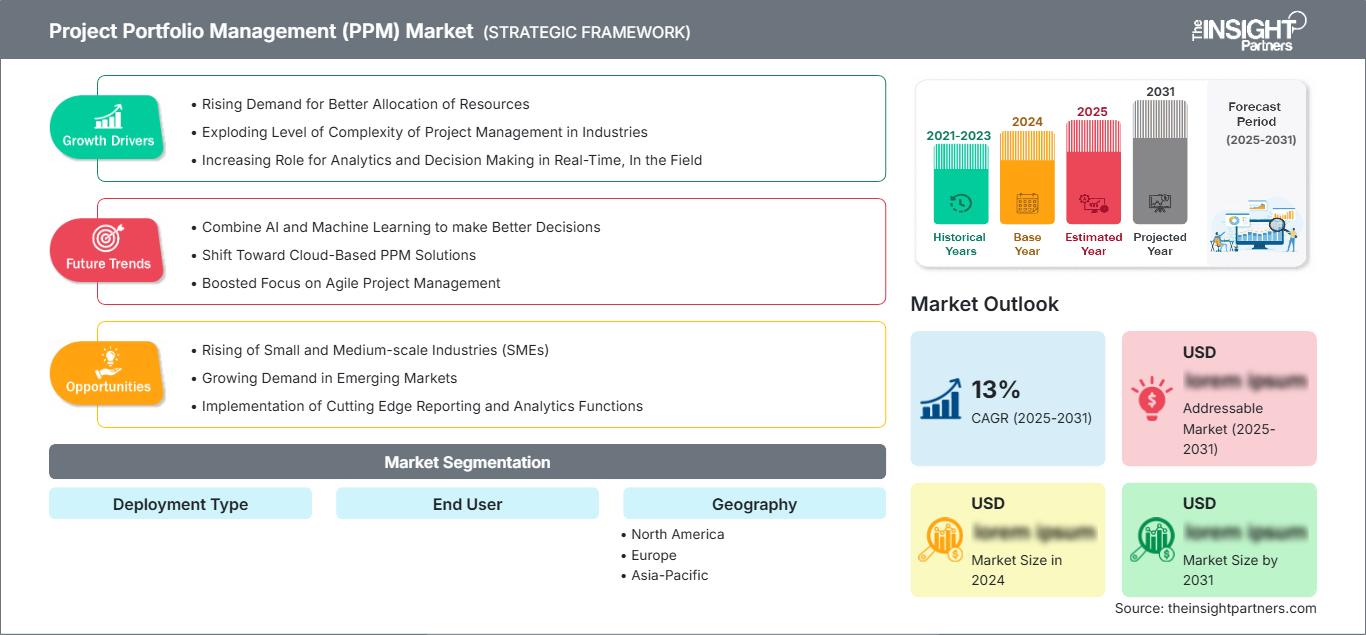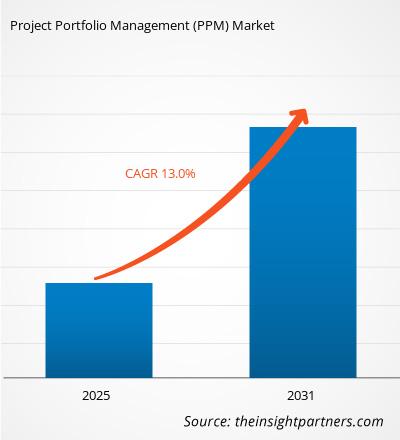Se espera que el tamaño del mercado de Gestión de Portafolio de Proyectos (PPM) alcance los US$ 12.21 mil millones para 2031. Se anticipa que el mercado registre una CAGR del 9,2% durante 2025-2031.
El informe de mercado de PPM segmenta el mercado de Gestión de Portafolio de Proyectos (PPM) según el tipo de solución, el modo de implementación, el tamaño de la organización y el sector vertical. Ofrece una visión regional completa de los mercados y países para una visión global. Las estimaciones de precios de mercado por región se presentan en dólares estadounidenses (USD), con estimaciones de CAGR para mostrar la evolución del mercado. Este informe ofrece un análisis integral de las condiciones del mercado, las tendencias de crecimiento y la competencia por regiones y segmentos.
Propósito del Informe
El informe "Mercado de Gestión de Portafolio de Proyectos (PPM)" de The Insight Partners busca describir el panorama actual y el crecimiento futuro, los principales factores impulsores, los desafíos y las oportunidades. Esto proporcionará información a diversas partes interesadas del negocio, como:
- Proveedores/fabricantes de tecnología: Para comprender la dinámica cambiante del mercado y conocer las oportunidades potenciales de crecimiento, lo que les permitirá tomar decisiones estratégicas informadas.
- Inversores: Realizar un análisis exhaustivo de tendencias respecto a la tasa de crecimiento del mercado, las proyecciones financieras del mercado y las oportunidades que existen en toda la cadena de valor.
- Órganos reguladores: Regular las políticas y las actividades policiales en el mercado con el objetivo de minimizar el abuso, preservar la confianza de los inversores y defender la integridad y estabilidad del mercado.
Segmentación del mercado de gestión de cartera de proyectos (PPM) Tipo de implementación
Usuario final
Obtendrá personalización en cualquier informe, sin cargo, incluidas partes de este informe o análisis a nivel de país, paquete de datos de Excel, así como también grandes ofertas y descuentos para empresas emergentes y universidades.
Mercado de Gestión de Portafolio de Proyectos (PPM): Perspectivas Estratégicas

-
Obtenga las principales tendencias clave del mercado de este informe.Esta muestra GRATUITA incluirá análisis de datos, desde tendencias del mercado hasta estimaciones y pronósticos.
Impulsores del crecimiento del mercado de gestión de cartera de proyectos (PPM)
- Creciente demanda de una mejor asignación de recursos: Las organizaciones también están adoptando soluciones de Gestión de Portafolio de Proyectos (PPM) para optimizar el uso de recursos en diferentes proyectos. Las soluciones PPM también ofrecen información sobre los recursos disponibles y las necesidades del proyecto, lo que permite asignar habilidades y recursos de forma eficiente. Más del 65 % de las empresas afirman obtener más beneficios de sus proyectos al gestionar mejor sus recursos con la solución PPM, lo que también explica el sólido crecimiento del mercado.
-
Aumento exponencial de la complejidad de la gestión de proyectos en las industrias: A medida que la gestión de proyectos se ha vuelto más compleja, con más proyectos simultáneos y distribuidos, y equipos geográficamente distribuidos, las herramientas PPM han cobrado mayor importancia. Las soluciones PPM automatizan los flujos de trabajo y mejoran el trabajo en equipo. Alcance del informe.
Perspectivas regionales del mercado de gestión de cartera de proyectos (PPM)
Los analistas de The Insight Partners han explicado detalladamente las tendencias y los factores regionales que influyen en el mercado de Gestión de Portafolios de Proyectos (GPP) durante el período de pronóstico. Esta sección también analiza los segmentos y la geografía del mercado de Gestión de Portafolios de Proyectos (GPP) en Norteamérica, Europa, Asia Pacífico, Oriente Medio y África, y Sudamérica y Centroamérica.
Alcance del informe de mercado de gestión de cartera de proyectos (PPM)
Asia-PacíficoPor usuario final Europa- Reino Unido
- Alemania
- Francia
- Rusia
- Italia
- Resto de Europa
- Porcelana
- India
- Japón
- Australia
- Resto de Asia-Pacífico
- Brasil
- Argentina
- Resto de América del Sur y Central
- Sudáfrica
- Arabia Saudita
- Emiratos Árabes Unidos
- Resto de Oriente Medio y África
Atributo del informe Detalles Tamaño del mercado en 2024 XX mil millones de dólares estadounidenses Tamaño del mercado en 2031 US$ 12.21 mil millones CAGR global (2025-2031) 9,2% Datos históricos 2021-2023 Período de pronóstico 2025-2031 Segmentos cubiertos Por tipo de implementación Regiones y países cubiertos América del norte - A NOSOTROS
- Canadá
- México
Líderes del mercado y perfiles de empresas clave - Tecnologías Ca
- Compañía de desarrollo Hewlett-Packard LP
- Planisware
- Corporación Changepoint
- Notas
- Corporación Oracle
- SAP SE
- Tecnologías Celoxis
- Vista en planta
Densidad de actores del mercado de gestión de cartera de proyectos (PPM): comprensión de su impacto en la dinámica empresarial
El mercado de Gestión de Portafolio de Proyectos (GPP) está creciendo rápidamente, impulsado por la creciente demanda de los usuarios finales debido a factores como la evolución de las preferencias de los consumidores, los avances tecnológicos y un mayor conocimiento de los beneficios del producto. A medida que aumenta la demanda, las empresas amplían su oferta, innovan para satisfacer las necesidades de los consumidores y aprovechan las tendencias emergentes, lo que impulsa aún más el crecimiento del mercado.

- Obtenga una descripción general de los principales actores clave del mercado de Gestión de cartera de proyectos (PPM)
- Análisis histórico (2 años), año base, pronóstico (7 años) con CAGR
- Análisis PEST y FODA
- Tamaño del mercado, valor/volumen: global, regional y nacional
- Industria y panorama competitivo
- Conjunto de datos de Excel
Informes recientes
Testimonios
Razón para comprar
- Toma de decisiones informada
- Comprensión de la dinámica del mercado
- Análisis competitivo
- Información sobre clientes
- Pronósticos del mercado
- Mitigación de riesgos
- Planificación estratégica
- Justificación de la inversión
- Identificación de mercados emergentes
- Mejora de las estrategias de marketing
- Impulso de la eficiencia operativa
- Alineación con las tendencias regulatorias






















 Obtenga una muestra gratuita para - Mercado de Gestión de Portafolio de Proyectos (PPM)
Obtenga una muestra gratuita para - Mercado de Gestión de Portafolio de Proyectos (PPM)